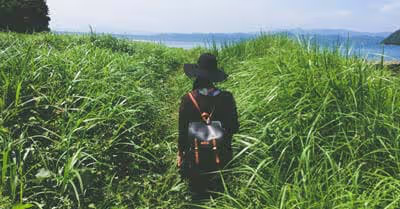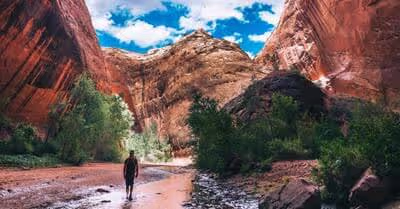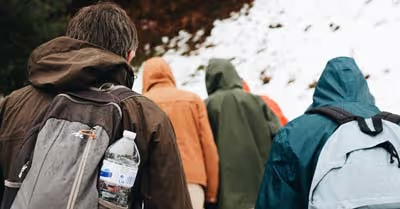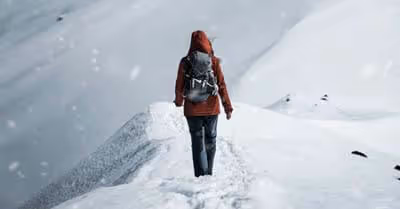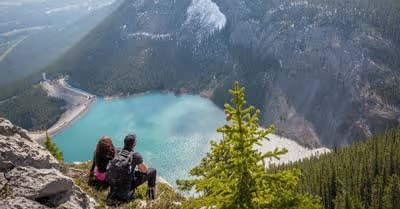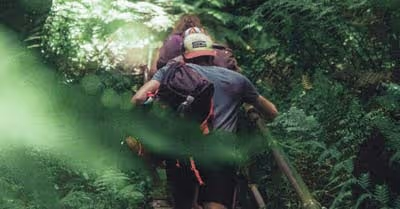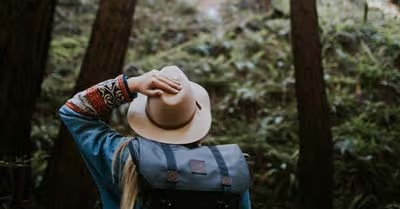Table of Contents
#1 A good backpack
First and foremost, you are going to want a very good backpack. What "good" is changes from person to person, but there are some consistencies we can look for. First of all, your backpack needs to be big enough for all your things. Even if your pack isn't one hundred percent full, a big pack is always worth it. Your backpack needs to be able to carry everything you are bringing with you. Even things that don't belong inside your bag from the get-go. For example, hats and scarves may be needed in a cold morning but by noon can be completely redundant. They need to fit inside your bag. You may need something to collect firewood in when camping, so the deeper the bag the better. A good backpack is also going to be water-resistant and tough. If you find all your belongings soaked through after a drizzle you are not going to be a happy camper.
#2 Enough fluids
Bringing enough fluids with you isn't as simple as just bringing a bottle of water. You will need about a gallon of water a day for hiking, more if you are hiking in very hot conditions. It is also a good idea to bring some fruit juice, a sports drink, and maybe even some tea or coffee. If you are going to be hiking for multiple days, you will want to bring some way of making more tea or coffee on your journey. As well as some way of purifying water. That could mean iodine tablets, a pot for boiling, a filter of some sort, or just a cup to drink from a clean stream. Fluids are vital, fluids are heavy. That's why having a decent water canteen is so important. You likely won't be bringing a full gallon jug of water, since it's so large and inconvenient to use.
#3 A first aid kit
A good first aid kit cannot be forgotten. Hiking the trails is dangerous, the chance for slipping and falling is very high. If not you, then someone else. It is much better to have a first aid kit and not need it than need one and don't have it. What a good medical kit contains is under a little bit of contention. Some people believe you need the works, a full trauma kit with all the bells and whistles. I disagree. So long as you have the very basics you should be fine. Bandages, slings, plasters, disinfectant, a needle and thread for stitches, some gauze, and some antibiotics/anti-inflammatories. All of these items can be found in a very basic first aid kit. Purchased from any outdoor store or distributor such as Amazon.
#4 A good pair of boots
A good pair of hiking boots is an absolute must. Without them, you are putting yourself at a disadvantage. Good hiking boots not only keep you safe by ensuring you always have a good grip on the trail but keep you comfortable. Hiking boots are designed to breathe, while also keeping your feet warm. Or cool, depending on whereabouts you are. A good pair of boots will also protect your toes from falling debris. This might sound a little silly, but rocks and logs get loose on the trail all the time. They can build up a fair amount of speed and do quite a bit of damage. If you find a rock tumbling towards your feet and you don't have boots, you should worry. A broken foot or twisted ankle can be the death of you out on the trail. Hiking boots have raised ankle supports for this reason.
#5 Spare laces
Spare laces are interestingly quite versatile. Of course, you get the benefit of having a spare pair of laces. If your laces break, tear, fray, or otherwise just fall to pieces - you are going to want a spare. Boots without proper laces are not going to be tight enough, this can cause injury or at the very least discomfort. Additionally, laces can be used for quite a few purposes. They can be used as a tie if needed, to secure canvas, to strap a pot or pan to your backpack. They can even be used to tie your clothes in a bundle to help them fit inside your bag more easily. A spare pair of laces can also be used to help stop the flow of blood by tieing it around your arm or leg as needed. They are tiny too, meaning you might as well bring them.
#6 Snacks
Snacks are so important! Hiking is hard work, bringing high energy snacks is the only way to ensure that you will be able to finish your hike. Hiking on an empty stomach with low blood sugar levels can lead to fainting, falling, and even death. It can also drastically reduce your ability to reason. You need your wits about you when you're in the wild. Some good snacks are granola and trail mix. High in sugar, carbs, and pretty dense. Compared to say, bread. They also require no preparation once you are out and about. Food that doesn't require any extra preparation is always a winner. Some fruit is nice too, a bag of apples and oranges would be a great thing to bring with you. And, they leave no garbage. It's fine to leave apple cores or banana peels in the woods. They decompose. Candy bars are good to bring, so long as you eat them in moderation. Refined sugars are a poor source of energy. They do make a nice treat though.
#7 A fire starter
Whether you plan on staying overnight or not, bringing something to help you start a fire is a good idea. For example, a waterproof flint and steel are pretty good. Matches and a lighter are great, but they are quite limiting. A flint and steel can list for ages. Thousands of uses if needs be. Plus, if the flint wears out you can just find more flint. You only truly need the steel part. Being able to start a fire is important for keeping yourself warm, cooking food, boiling water, etc. Most fire starters are pretty small, so you don't need to worry about lugging around all that extra weight.
#8 Layers
Extra layers are very important. If you are in very cold conditions then an extra layer might save your life. Even in warm places, spare layers are good. Swapping out of your horrible sweat-soaked shirt into a clean fresh one feels great. There is also the potential for getting very wet, swapping out of your wet clothes into some dry ones can be a matter of safety as well as comfort. Clothes can also double as a bandage if needed. A torn up t-shirt makes an excellent bandage when you're in a pinch. Extra layers don't just mean more shirts. Socks, hats, sweaters, long-johns should all be included in your inventory if possible.
#9 Map & Compass
This one may seem a little obvious, after all, who doesn't bring a map and a compass with them when they are hiking on the trails. Unfortunately, lots of people don't do that. For no good reason other than the fact that they can't be bothered. A compass is easy enough to get. Unlike a map, which is of course very regional, a compass can be used anywhere on earth. Orientating yourself to the earth magnetic poles is sometimes enough on its own to find your way. If you know you are hiking north, and its time to get home, then following your compass south will spit you out somewhere in the right direction. A map should be purchased, or downloaded and then printed out, and stored in a water-sealed bag. A map that is water damaged may not do you much good. It might be fine, but why run the risk for the sake of saving a few dollars by not purchasing a water-sealed bag.
#10 Satphone
A Satphone is unfortunately not quite as cheap as some of the other items listed here. A good Satphone may set you back anywhere from a couple hundred to a couple of thousand dollars depending on make and model. However, you should be fine with just a basic model. Just enough to give you a general lay of the land and call in help. A Satphone can save your life, or someone you're with, or someone you meet on the trail. The cost may be a little hard to stomach. But its a truly sound purchase. Besides, you buy one and that's it. If you hike in a group, going in one together might be the best way to circumnavigate the cost. A Satphone is a good thing to store in your car too, in case you break down in the middle of nowhere.
#11 Bear Spray
Bear Spray is mace on steroids. Its mace so powerful that it can debilitate a grown grizzly bear. It's big, it's powerful, and a bear stands no chance. Some canisters require you to spray at the bear. Some you pretty much throw on the ground and run away. The spray will "blind" them and freak them out, they'll run off in a panic. Don't worry, there will be no permanent damage to the bear. Just enough so that you have time to run away. As far away as possible. Make sure you do run away though or at least turn away as you spray. Because I can assure you that the spray will do more damage to your eyes than the bear if you accidentally spray yourself. Also, never open it indoors. You will gas attack your entire house.
#12 A plan
Okay, so this one isn't so much an item but an idea. Whenever you go hiking, even short distances, you need a plan. It doesn't need to be a detailed hour by hour, step by step, plan. Just a vague idea of what's happening. For example, knowing where you are going and where you are is a nice basis. Learning some natural landmarks or trail markers to watch for is also a good idea. Knowing you need to reach a certain point by a certain time helps you gauge where you're at and where you're going. Measuring speed when hiking is hard, using trail markers is a better way to check pace. A plan could also mean packing what you need, planning your meals, and estimating your water consumption.
Conclusion
Hopefully, this article has answered any questions you may have had. All of these 12 essentials should be given your full consideration. You can fit everything here into a decent 40L backpack. A good backpack being the first item in the list is an indication that you need to buy one big enough! If you had to pick just a few items, the backpack water, and fire starter is the way to go. You can carry all of these things comfortably. These three things can keep you alive for weeks if needs be. That being said, you should be able to afford everything. The only thing that I would consider more of a luxury item is the SatPhone. If you can stomach the cost, the SatPhone will make a fine addition to your hiking arsenal!
Recent Articles



